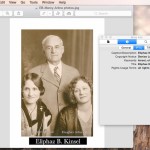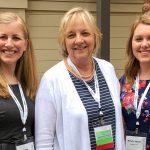Then I found CensusMate, a handy census utility by John L. Haynes that stacks data in a grid for easier analysis. Instead of the typical individual census extracts, Mr. Haynes proposes a timeline arrangement for data from pre-1850 censuses. Males are placed on one line, with females listed below using the same age brackets. This allows the researcher to follow a given individual from decade to decade and to see patterns within family groups.

In addition to free census forms, Mr. Haynes also provides careful examples with explanatory notes. His sample family provides an understandable key for using the forms in your own research.
I applied Mr. Haynes principles to my study of Henry Winsor using the family of Henry’s guardian as my subject. Would Henry fit into this family grouping?
The example shows that in 1820 (before Henry was born) the Dyer family included 2 boys and 1 girl 0-9, 2 boys and 2 girls 19-15, 2 boys and 1 girl 16-25, 1 male over 45, and 1 female 26-44.
In 1830, when Henry was 9 years old, but one year before Edward Dyer was appointed his guardian, the Dyer family could account for the children in the 1820 census PLUS 2 boys and 1 girl 10-19, and 1 girl 5-9, as well as older adult children.
In 1840, the same pattern appears. The Dyer family suddenly includes 1 boy 10-14 and 2 boys 15-19. These children do not appear in the corresponding age brackets for the 1830 census.
My ancestor, Henry M. was 9 years old in 1830 and does not appear in Edward Dyer’s household. Perhaps he was living with a relative or neighbor until the court order of 1831 appointed Dyer as Henry’s legal guardian. In 1840, Henry could have been one of the two 15-19 year olds listed in Dyer’s household. Where did the other boys come from?
I wonder if Edward Dyer had the social and financial standing to act as a guardian or foster parents for other children. In 1820 the Dyers had 3 children age 0-9; in 1830 these 3 children should have fallen into the 10-19 age bracket; however, this age group shows a total of 6 children. Again, in 1830 the Dyers had 1 child under 9; in 1840 they had 4 children 10-19. It looks like the Dyers were taking in the children of relatives or others in the community.
John Haynes CensusMate forms makes such relationships much more clear. Additional forms assist the researcher in determining birth or death years by using the stacked census data and the linear timeline.
By using CensusMate, I discovered a new avenue of research: the Edward Dyer family. A brief Google search shows numerous hits; the Dyers seem to be a well-established Vermont family. Perhaps further research will lead to information about their children and household, and maybe even my elusive ancestor, Henry M. Winsor. Thank you, Mr. Haynes. CensusMate is a GEM!







Denise,
Thanks for your kind comments. It's wonderful to read that you found a new path to family history with CensusMate. Happy hunting!
John